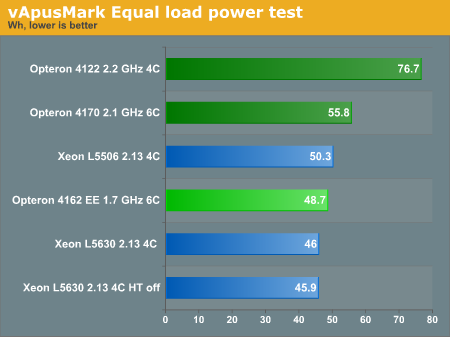Balancing Power, Price, and Performance in the Server CPU World
by Johan De Gelas on March 3, 2011 7:07 PM EST- Posted in
- IT Computing
- AMD
- Intel
- 1000W
- Xeon
- Opteron
- Cloud Computing
Real-World Power Use
In the real world you do not run your virtualized servers at their maximum just to measure the potential performance, but neither do they run idle. The user base will create a certain workload and expect this workload to be performed with the lowest response times. The general idea behind this new benchmark scenario is that each server runs exactly the same workload and that we then measure the amount of energy consumed. You can find more detail about our real-world power test here.

You get what you pay for of course. The Opteron 4122 is extremely cheap, but these are the most leaky chips that pass the quality tests. Remember the quad-core 2.2GHz will consume at the most 95W (or almost 25W per core) while the hex-core 4170 HE will never pass 65W (11W per core) despite the fact that they are running at almost the same clockspeed (2.1GHz). So the 4170 HE is roughly more than twice as efficient.










35 Comments
View All Comments
pvdw - Thursday, March 10, 2011 - link
Don't worry duploxxx, no company in their right mind would hire him. And those who do, deserve what they get for just hiring a zealot with little to no expertise.pvdw - Thursday, March 10, 2011 - link
He's just a mindless troll, let's ignore him.theangryintern - Friday, March 11, 2011 - link
This is a bit OT, did I miss the full article about AnandTech's server upgrade, or has the story not been posted yet? I remember we got a couple preview articles, and now nothing for several months. I was really interested in seeing the full story of the upgrades.gujiong2002 - Tuesday, April 5, 2011 - link
Typo?meorah - Wednesday, April 20, 2011 - link
Its too bad the benchmarks didn't include comparisons to a mainstream processor like the E5620. That way we could get a sense of scale between all the low power processor performance/power usage levels.In other words, if the E5620 is only slightly worse than the low power processors, it makes the scale smaller so the differences between the low power processors are more pronounced, similar to the charts in the article.
However, if the E5620 is much worse than the low power procs, it makes the chart scale much higher and suddenly the relative difference between the low power procs seems almost insignificant.
I understand the concept of max density and therefore max performance/watt for datacenters, but there are plenty of small businesses with 1-4 racks in a corporate site computer closet running back-office systems who are also interested in balancing TCO on a smaller scale, and including a mainstream proc in your charts would help them (me). :)